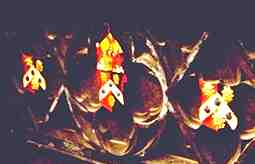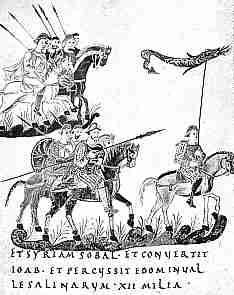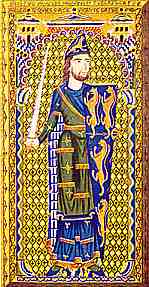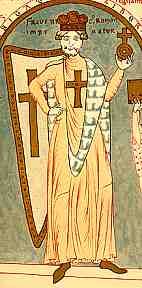 |
| Works
on Heraldry |
| The
imagery of heraldry provides one of the definitive visual concepts of the
middle ages. It combines in our minds with chivalry and feudalism to crystallise
major concepts of medieval life. It has an arcane vocabulary and complex rules,
but in fact, a great deal of this dates from the later middle ages, and even
into the Tudor period in England. |
 |
The
face of a late medieval tomb chest in Newark parish church, with heraldic
shields restored to their proper colouring. |
|
Ever
since boys started fighting each other, probably over a decomposing wildebeest
carcase a few million years ago in Africa, people have adopted insignia to
identify themselves and distinguish friend from foe. The intricate system
of heraldry which began in the middle ages seems to have developed some formal
rules around the 12th century, and these became more complex later. |
 |
In
this Carolingian era manuscript,
the mounted soldiers are following a standard, rather in the Roman manner.
Whatever the standard is supposed to represent, it was no doubt intended
to act as an identifying symbol and rallying point. There are no obvious
signs of individual heraldic devices. |
A
Carolingian manuscript depicts mounted soldiers armed with lances and shields
going to war behind a standard bearer (St Gall, Bibl. conventuelle, ms.22).
|
|
|
Drawing
from a segment of the Bayeux Tapestry. |
|
The
Bayeux Tapestry, believed to have been executed very soon after the events
of 1066 and an authentic witness, if just a wee bit biased to the Norman side,
shows the combatants bearing coloured shields and carrying banners. There
is nothing like the distinct heraldic markings and insignia of later times. |
|
The
costume worn by soldiers to the Crusades is believed to have contributed to
the development of heraldry. While clattering along through foreign lands
it was pretty important to be identified as a fighter for Christianity rather
than a wandering vagabond, and the long surcoats worn over their chain mail
armour, as well as their long shields, provided a canvas for conspicuous identifying
symbols. The Christian cross was the most important emblem to display at this
stage of proceedings. |
|
|
Drawing
after an image of Friedrich Barbarossa as a crusader, from a Bavarian Manuscript
of 1188 in the Vatican Library. |
|
The
image at right is composed of purely symbolic elements. The emperor wears his
crown and carries an orb to indicate his temporal authority. While not in
armour, he displays the emblem of the cross on his clothing and shield in
the manner of the crusading knights. |
 |
The
first known example of personal armorial bearings were those bestowed on Geoffrey
Plantagenet, also known as Geoffrey of Anjou, in 1127 by King Henry I of England.
He married Matilda, the daughter of Henry, who produced the future Henry II
of England and founded the Plantagenet line of kings. His coat of arms of
six gold lions on a blue ground is preserved in full glowing colour on his
enamelled funeral slab, now in the Musée Tessé in Le Mans, from
which the image at left is derived. The lion on a blue ground also appears
on his helmet. |
|
Geoffrey
Plantagenet with his coat of arms. |
|
|
Tomb
of William Longspee, Earl of Salisbury (d.1220) in Salisbury Cathedral. |
|
The
fact that this was regarded as a hereditary privilege is shown by the effigy
on the tomb of his grandson, William Longspee, in Salisbury Cathedral. The
six lions are shown carved in relief on his long shield. Undoubtedly this
tomb would have been coloured to show it in its full glory, but a certain
post-medieval aethetic has ensured that most medieval sculptures in churches
have been scrubbed back to the stone. |
|
So,
the heraldic thing was being done, at least at the level of a personal coat
of arms, in the 12th century, but when did they start writing about it and
setting out the rules? |
|
continued
 |
 Categories
of Works Categories
of Works |
.
|
 |
 |
 |
 |
 |





